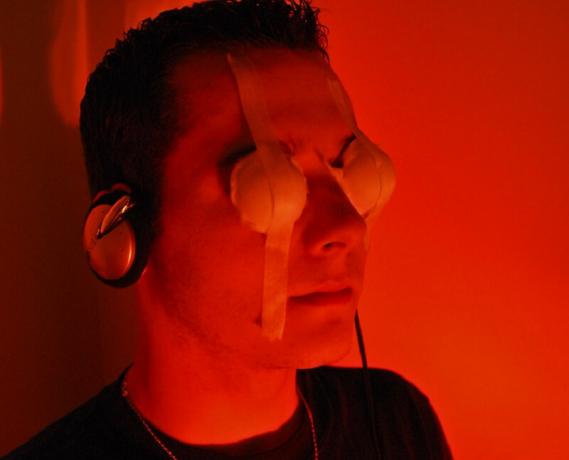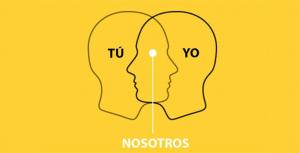Ganzfeld effect: what it is, characteristics and how it was investigated
Is there telepathy? At the moment everything seems to indicate that noSince there is no reliable experiment that has shown that one person can transmit their thoughts to another through psychic waves.
Despite this, there are not a few who are still interested in demonstrating that telepathy exists and one of the most used methods to verify it is with the Ganzfeld experiment.
Also known as the Ganzfeld effect, this consists of making a person find himself in a sensory deprivation situation in order to to get him to be more sensitive to what someone is trying to say without articulating word. Let's dive into this curious and interesting parapsychological experiment.
- Related article: "Types of brain waves: Delta, Theta, Alpha, Beta and Gamma"
What is the Ganzfeld effect?
The Ganzfeld effect or Ganzfeld experiment (German for "homogenized field") is a technique used in parapsychology to, supposedly, verify the existence of telepathy and extrasensory experiences. The premise behind this idea is that, in order to observe a telepathic phenomenon under experimental conditions, the deprivation of the senses of the experimental subject, facilitating the reception of information from other sources, generally images.
Those who apply this experiment affirm that when one is exposed to a uniform stimulation field and not structured, such as seeing blackness and hearing a constant sound, such as the static of the TV, the brain responds by amplifying neural noise in order to find missing visual and auditory signals. From a parapsychological perspective, this would be what would allow us to pick up telepathic signals from other people, although it could also result in visual and auditory hallucinations.
This peculiar experiment has gained popularity in recent years for studying telepathy, but it It is true that it is quite old, attributing it to the German psychologist Wolfgang Metzger in the decade of 1930. Metzger is considered one of the most important figures in Gestalt psychology, a current that emerged in Germany at the beginning of the last century. Metzger suggested that when people looked at a featureless field of vision they were able to see things that weren't really there.
Despite being a rather interesting experiment, it is important to mention that there are not a few scholars who point out that this technique lacks the slightest reliability due to the lack of preparation of the subjects, the conditions of the space used and, of course, the fact that the study of telepathy is more part of the esoteric world, no matter how hard you try to study it from an experimental psychology perspective.

- You may be interested in: "History of Psychology: main authors and theories"
History of the phenomenon
Since time immemorial, human beings have wanted to know if telepathy exists. Being able to transmit words, images or even feelings through our mind, without having to say a single word, is something that attracts because of its aura of mystery but also because of how functional it would be to be able to talk to someone without others giving bill.
It is believed that the first studies on sensory perception and extrasensory experiences were carried out by the aforementioned psychologist Wolfgang Metzer in the 1930s, who raised the possibility that human beings were capable of reaching these states under certain conditions of deprivation sensory. By reducing the perception of physical stimuli, one person could be able to capture the thought of another without the need to speak.
Several decades later, in the 1970s, the first formal experiments on this question were carried out under the supervision of the American parapsychologist Charles Honorton, interested in analyzing dreams and discovering if the telepathy. To achieve his goals, Honorton made use of the Ganzfeld effect by depriving and limiting the senses of his experimental subjects.
- Related article: "Parts of the human brain (and functions)"
The Honorton Studies
Honorton's experiments on telepathy began in 1974 in different laboratories, all of them aimed at verifying the existence of extrasensory perception regardless of the environment in which it was carried out. This set of experiments were carried out for several years, continuing until 2004.
Honorton himself submitted an article in 1982 to the annual convention of the Parapsychological Association that He "confirmed" having had a success rate of 35%, "proving" the existence of the experiences extrasensory. However, when these data are presented, psychologist Ray Hyman pointed out a series of failures that occurred during the experiments, which would have contributed to altering the results.
Both Honorton and Hyman studied these results separately with the goal of further analysis. After a short time, what Hyman had said was confirmed, which evidenced the need to apply stricter controls during the performance of these parapsychological experiments.
In 1989 these experiments were replicated, obtaining results more or less similar to those obtained in the first Honorton experiment. At this point, Hyman asked the entire community of experts and psychologists to carry out these same experiments independently., in order to draw more precise conclusions from a greater amount of opinions and evidence.
Although he continued with the studies to demonstrate the existence of telepathy, involving several laboratories and scholars, it has not been verified or obtained reliable evidence that this parapsychic phenomenon exist. In fact, some of the results obtained were inconclusive or were criticized for the lack of rigor in the experiments.
- You may be interested in: "17 curiosities about human perception"
How is the Ganzfeld experiment done?
The main objective of the Ganzfeld effect is to verify the existence of extrasensory perception. In order to achieve this, it is necessary to have a series of requirements:
- You must have a totally empty room, completely soundproof and dark.
- In some cases you can have a red light on, but the other two requirements are fundamental and must be strictly respected.
- The only furniture that can be in the room is a comfortable chair or bed on which the experimental subject can lie down.
The experiment begins by taking an item that can be placed over the subject's eyes in order to prevent him from seeing. In many cases, this phase begins by picking up a ping-pong ball, splitting it in half, and placing each piece on top. the participant's eyes, although this step can be done more professionally by taking special glasses or using a mask.
Subsequently, hearing aids are fitted to the subject, making you hear a smooth and continuous noise, without interference. This sound should isolate it from possible accidental noise made by others involved in the experiment while in the room.
The experiment usually involves three people:
- The receiver, who is in the room.
- The emitter, which will be located in another space or far from the receiver.
- The researcher, who will be in charge of reviewing and monitoring the results.
Phases of the experiment
Next we will see in detail the phases of the Ganzfeld experiment.
Phase 1
The receiver's senses will be limited for about 15 to 30 minutes. The objective of this first phase is to achieve that the participant manages to reach a state of relaxation but without falling asleep.
Phase 2
Phase 2 occurs with the subject totally relaxed, but making sure that he is not asleep. To make sure you maintain awareness, You can talk to him either through headphones or by reaching out and asking if he is asleep. This should be done in the least disruptive way possible.
Phase 3
In phase 3, the sender will begin to see images, either on a screen or having some photos that the researcher will have given them, and she will try to send them telepathically to the receiver. The investigator will record the reactions that are taking place during this moment.
At the end of the telepathic bombardment, the receiver must identify which images were sent by the sender. The researcher will have some decoys in order to confirm if the experiment has been successful..
critics
There are several weak points in the experiments in which the Ganzfeld effect has been applied to demonstrate the existence of telepathy. In early experiments it used to be that no all rooms were soundproof or completely empty, which could have affected the perception of the study subjects.
Added to this, the way in which the subjects were chosen was not rigorous or methodical, and like those who do these experiments parapsychologicals often lack real scientific knowledge, their experiments often have serious flaws in their design experimental.
- You may be interested in: "Hallucinations: definition, causes, and symptoms"
Hacking the brain with the Ganzfeld effect
Our brain is a machine that, as long as it is not injured or ill, works very efficiently. Despite this, this organ can be fooled with relative ease and the perfect example of this is optical illusions. Although the Ganzfeld effect was originally conceived to demonstrate the existence of telepathy, It seems that it serves to demonstrate a phenomenon that we could well consider the opposite: that of being able to hack the brain.
With the Ganzfeld experiment we can make a person feel confused, live the situation in which they are finds it very strange and disturbing without the need to resort to the consumption of chemicals of any kind, just using sensory deprivation, something that the youtubers of Scam Nation demonstrated in a video on their YouTube channel.
These content creators created a sensory deprivation situation using some common household items such as tape, string, sheets of paper, cottons, and other items. To get rid of the surrounding noises, they used headphones through which white noise could be heard from a recording hung on the own video viewing platform, playing without pause for at least 30 minutes and serving to cancel the noise of the bedroom.
They noticed the effects last between 10 and 30 minutes, sure to see "colored flowers" similar to when you rub your eyes hard and, later, they began to see shapes like dinosaurs, jellyfish and, even, there came a time when they saw something similar to the "Eye of Sauron" from the "Lord of the Rings" saga. They also had auditory hallucinations, hearing one screaming and the other laughing.
Thanks to elements of going around the house, the guys at Scam Nation managed to create an atmosphere similar to the one gave in the Honorton experiments, also replicating the same thing that happens in isolation tanks sensory.

